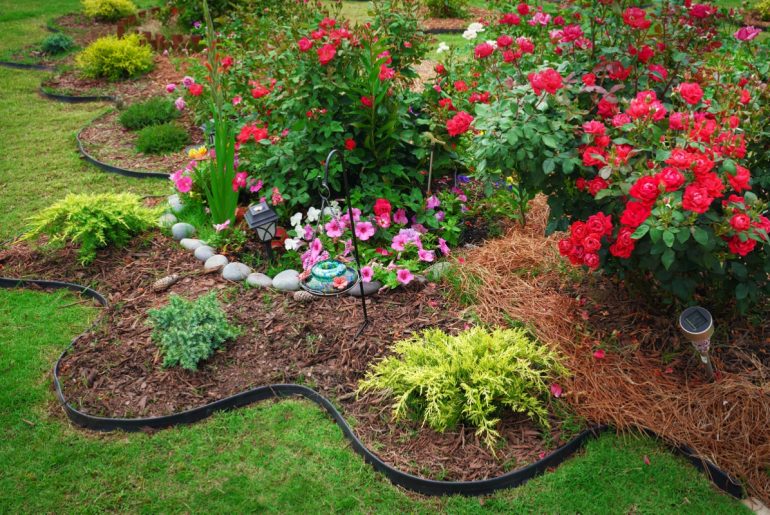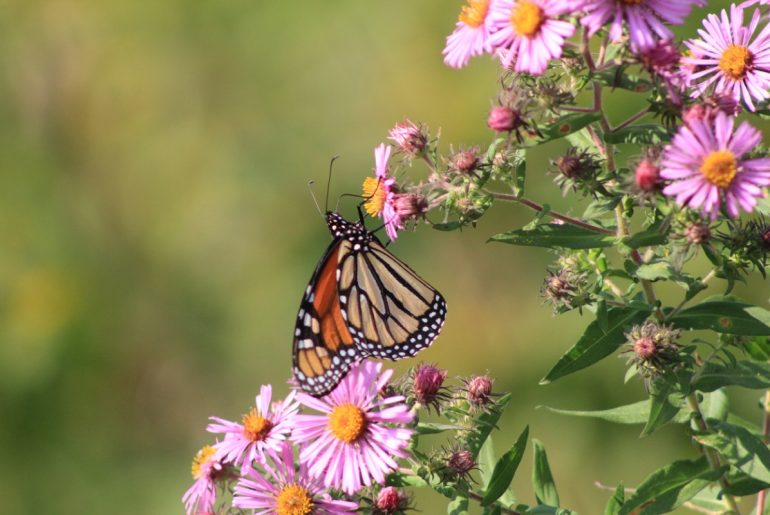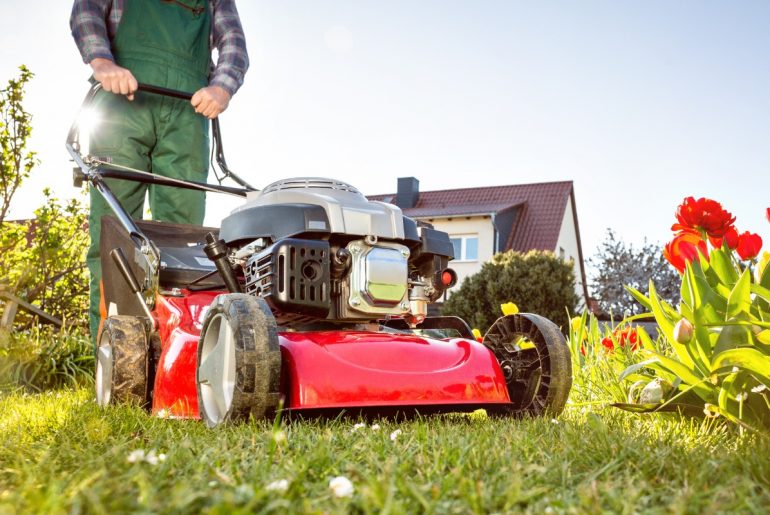Landscaping around house foundations is a must to protect structural integrity. If the area surrounding the home’s foundation is not properly maintained, it can cause damage to a house, such as water damage, termite infestation, and unruly weed overgrowth.
To better protect the structural integrity of houses, it is best to landscape the area surrounding the foundation. A common practice that yields the best results is to landscape from the base of the foundation to ten feet away from the base with sustainable and protective material.
The best materials to landscape around a foundation will inhibit weed growth, provide a proper water drainage system, and won’t attract pests. With years of landscaping experience, we have determined that the four best landscaping materials around the foundation are gravel, rubber mulch, concrete, and brick masonry.
Top 4 Landscaping Materials to Protect Foundations
Determining what material to use for landscaping around house foundations is time-consuming. The need to protect the foundation, and ensure curb appeal makes the process even more difficult. Several landscaping materials can both provide curb appeal and necessary protection.
Consider these top 4 landscaping materials to protect a home’s foundation for your next home project.
1. Gravel
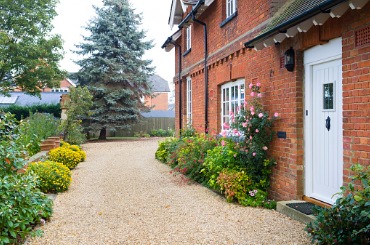
Laying gravel around the house as a foundation landscaping material helps ensure your foundation stays protected from outside elements. Along with its protective nature, gravel landscaping ideas and gravel provide a natural look that can be spruced up to fit your overall landscaping style and rock landscaping ideas.
Gravel comes in all different shapes and sizes making it a versatile landscaping material. Whether you prefer the traditional limestone for its looks and price point or you prefer the more whimsical look of river rock, gravel proves beneficial for foundation protection.
Using smaller types of crushed stone, such as pea gravel, can cause issues applying to the gravel bed. Because it is so small, it can easily escape the bed and end up in the yard or surrounding areas. It also poses a risk for outside pets and wildlife to use it as a bathroom spot.
Larger gravel types such as pebbles and river rock are typically easier to work with and you don’t need as much to fill the bed. If using landscaping rock or limestone, beware of the sharp edges and potential hazards they may pose to pets and children.
Benefits of Gravel for Foundation Protection
From its assistance in drainage to heat distribution, gravel should be at the top of your list when considering foundation gravel landscaping. Here are some of its top benefits:
Prevents Overgrown Weeds

Gravel helps prevent weeds from overgrowing around your foundation due to the gravel bed build process. A weed membrane is installed to help prevent unwanted growth when preparing the ground around the foundation for the gravel.
Topping the weed membrane with a layer of gravel is extra protection around the foundation that discourages weed growth. In turn, the foundation will not have to fight unwanted shrubs and weeds, creating minimal maintenance and tidy-looking foundation protection.
Natural Drainage
It’s no secret that gravel aids in good drainage efforts. One particularly effective method is using rocks to divert water. Doing so around a house’s foundation helps prevent water from gathering, ultimately ensuring minimal risk of basement flooding. This method not only aids in drainage but also directs the flow of water, thus acting as a protective barrier for your home.
Not only does gravel ensure water flow moves quickly through the area, but it also prevents plants within the bed from receiving too much water and drowning. The prevention of puddle formation and soil saturation proves an extensive benefit to gravel beds.
When it comes to landscaping to divert water from the house, gravel is an excellent option. It is vital to note the benefit of rocks around the house for drainage. Ensure the gravel bed does not slope towards the foundation. If it does, the gravel can have the opposite effect and aid in trapping the excess water next to the foundation.
Prevents Excess Moisture
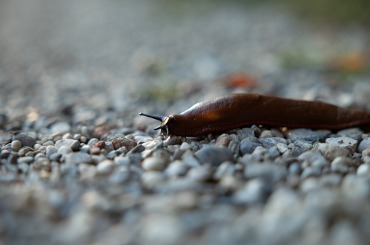
Much like its swift drainage capabilities, gravel won’t retain moisture, making it an excellent pest deterrent. Pests often thrive in moist conditions and wreak havoc on a house’s foundation. Ensuring as little moisture levels as possible around a home’s foundation helps protect it from termites and other pests.
While guaranteeing the dry soil beneath the gravel won’t hold moisture is impossible, the aid in puddle prevention and swift runoff help prevent excess moisture.
Aids in Heat Distribution
One benefit of gravel beds for landscaping foundations that is often overlooked is their aid in heat distribution. Because rocks retain heat from the sun, they remain warm after the sun goes down and the temperature drops. This process helps keep the foundation warm and any plants that call the gravel bed home.
2. Rubber Mulch
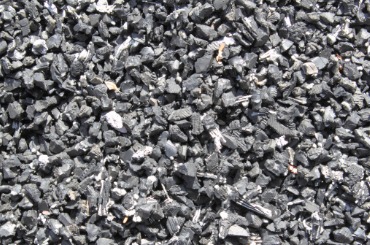
Rubber mulch is a productive landscaping material to use around foundations and keeps growing in popularity. While rubber may not be your initial thought when you hear the term mulch, rubber mulch makes an excellent landscaping product.
While it’s not the best material to use around young plants or trees due to its synthetic makeup, rubber mulch around the house poses multiple benefits to foundation landscaping. If you decide to move forward with rubber mulch for its insulating benefits or perhaps its minimal maintenance, the product doesn’t disappoint often.
Keep in mind that rubber contains various harsh metals and chemicals that can cause harm to living beings. Therefore, using rubber mulch may not be the best idea if the home is in a hot climate or houses a family sensitive to heavy metals like aluminum, zinc, and cadmium.
Although there are minor health risks associated with using rubber mulch, it is an excellent landscaping alternative to wood mulch and is easy to maintain.
Benefits of Rubber Mulch for Foundation Protection
Rubber mulch benefits for foundation protection range from its ability to stay in place to its lack of maintenance needs.
Insulates
The insulation aspect of rubber mulch as foundation protection is a significant benefit and draw to the product. Not only does it protect mature shrubs and trees from dehydration, but it also keeps the home warmer.
Keep in mind that when the rubber gets too hot, it can release chemicals and also overheat the soil. This poses a minor threat to any plants in the mulch.
Doesn’t Attract Pests
Unlike organic mulches, rubber mulch acts as a deterrent for termites and other pests. Pests don’t like to live in areas where they cannot feast on their surroundings. Therefore, rubber mulch barrier ideas keep these pests from calling the area surrounding the foundation home.
The inedible rubber mixed with the smell of the chemicals that make up the rubber ensures pests don’t mistake the landscape for a spot they want to live or feast.
Little to No Maintenance
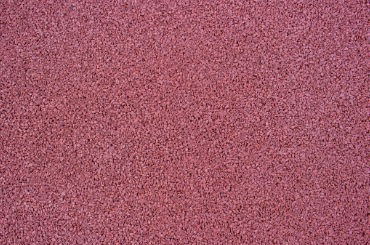
Due to the synthetic makeup of rubber mulch, those who use this material will not find themselves replacing it year after year. Instead, its slow breakdown process causes it to last for roughly ten years before needing replacing. Understanding the longevity of rubber mulch is a big selling point as it makes the higher price tag seem more relevant.
Rubber mulch also looks fresh throughout its lifespan. This means it doesn’t have to be cleaned regularly, which helps keep curb appeal on point with minimal effort.
Prevents Weed Growth
As with organic mulch, rubber mulch helps prevent weed growth. The rubber compounds are not quite as effective as organic materials at preventing weeds from coming to the surface, but they do inhibit weed growth.
For rubber mulch to make a noticeable impact on weed growth, a layer of two to four inches of mulch is necessary.
Start Using Landscaping Software!
3. Concrete
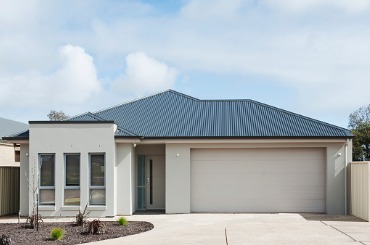
Concrete adds additional strength and durability to the home’s base foundation. Home foundations are often poured with concrete. Therefore, using concrete as a foundation landscaping material essentially makes it a foundation extension.
This means that the foundation has added durability and a uniform look. One of the key benefits of using concrete is that it is relatively inexpensive, making it easier on the wallet. Easy installation, added durability, and price point are just some of the benefits of concrete.
There is a reason that concrete is so widely used on construction sites. The strength, durability, versatility, and cost-effectiveness make it a highly sought-after material.
Benefits of Concrete for Foundation Protection
If looking for a sustainable landscaping material that is cost-effective, durable, and requires low maintenance, concrete may be the top contender.
Added Durability
As previously noted, adding a layer of concrete around a home’s foundation adds an extra layer of strength and durability to help support the home. This added durability goes beyond structural support as concrete also creates a water-tight barrier around the foundation helping prevent flooded basements and water damage.
Price Point

Concrete is in abundance which ensures its cost-effectiveness as a landscaping material. If the foundation that is being landscaped has a large base, concrete helps ensure the job will be completed without running out of funding or going over budget.
Prevent Weed Growth and Pest Infestation
One of the key benefits of landscaping around a foundation with concrete is its ability to prevent weed growth and pest infestation. The solid structure won’t allow unruly weeds to pop up around the home and create an unappealing view from the curb.
The lack of weeds means homeowners don’t have to spend hours fighting the weed growth just to keep an aesthetically pleasing curb appeal. The lack of weeds and other organic materials around the base of the foundation also means pest infestation is highly unlikely.
Low Maintenance
Landscaping with concrete means little to no maintenance. Concrete also tends to age well if installed correctly, meaning it’s one of those materials you can install and not have to think twice about. It is also easy to clean as a broom or power washer will keep it looking like new.
4. Brick Masonry

Brick masonry is one of the most popular foundation materials. Not only does it provide homes with a strong and durable foundation, but it is also cost-effective and aesthetically pleasing.
Brick masonry is often reinforced with steel bars to ensure proper strength to help withstand extensive weight, which is one of the reasons it is so popular in construction. The durable material can be used to structure house foundations and provide foundation protection.
Whether the brick masonry installation around a home’s foundation is the traditional brick red, or a more modern gray or white, the brick masonry adds a color-popping feature to a home’s landscape. In addition to the color variance brick adds to curb appeal, brick design is another eye-catching feature not to be overlooked.
The mixture of structural support and pleasing aesthetics makes brick masonry a popular foundation landscaping material.
Benefits of Brick Masonry for Foundation Protection
Whether deciding to use brick masonry for its strength and durability or the color it adds to a landscape, this foundation landscape proves beneficial in multiple ways.
Structural Support
As previously noted, brick is one of the toughest and most used materials for building structures. Therefore, having an additional bricklayer around your foundation provides any additional, necessary support.
Prevents Pest Infestations
Much like gravel, brick masonry helps prevent pest infestations because it does not hold moisture like other materials. The solid brick makeup mixed with the tight installation leaves little room for moisture to sink into the soil beneath.
Discourages Weed Growth
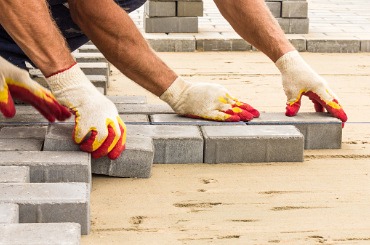
Because brick design is unique and fits together in a puzzle-like pattern, it is tight and secure, leaving little room for weeds to pop through. While some weeds do make a resilient effort to break through the seams, they are scarce and easy to spot, making them easy to remove.
Before beginning the brick masonry as the foundation landscape, consider lining the ground with a weed membrane to prevent weeds from invading the area.
Easy to Clean
After several years of exposure to natural elements, the brick may begin to show algae growth. Luckily, the brick is easy to clean, helping keep the home looking fresh and up-to-date.
When it comes time to clean exterior brick masonry. Grab the hose or power washer and spray the brick for a quick and easy clean.
When using a power washer, ensure the brick can withstand the pressure. The brick does decay over time, and depending on the type and age of the brick, it can chip away under pressure.
Aesthetically Pleasing
Brick designs are a masterpiece as the red coloration creates an eye-catching pop to a seemingly neutral color scheme especially if used for a retainer wall. If you’re looking for foundation landscaping to bump up the aesthetics of a home’s exterior, consider brick masonry.


